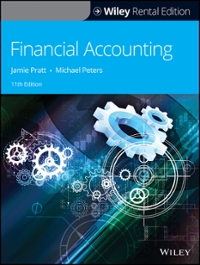Question
11. Harding, Jones and Sandy is in the process of liquidating and the partners have the following capital balances: P20,000, P22,000 and P(10,000) respectively. The
11. Harding, Jones and Sandy is in the process of liquidating and the partners have the following capital balances: P20,000, P22,000 and P(10,000) respectively. The partners share all profits and losses 50%, 35% and 15%, respectively. Sandy has indicated that the P(10,000) deficit will be covered with a forthcoming contribution. The remaining partners have requested to receive P18,382 in cash that is available. How should this cash be distributed?
A. Harding P8,000; Jones P18,382
B. Harding P6,107; Jones P12,275
C. Harding P7,500; Jones P18,882
D. Harding P10,813; Jones P7,569
12. A, B and C have capital balances of P80,000, P80,000, and P40,000, respectively. Profits are allocated 40% to A, 40% to B and 20% to C. The partners have decided to dissolve and liquidate the partnership. After paying all creditors the amount available for distribution is P20,000. A and B are personally solvent. C is personally insolvent. Under the circumstances, A and B will each
A. Receive P8,000.
B. Receive P9,000.
C. Receive P10,000.
D. Receive P6,000.
13. The ABC partnership has the following capital accounts on its books at December 31, 20x4:
Credit:
A, Capital P200,000
B, Capital 120,000
C, Capital 40,000
All liabilities have been liquidated and the cash balance is zero. None of the partners have personal asset in excess of his personal liabilities. The partners share profits and losses in the ratio of 3:2:5. If the noncash assets are sold for P150,000, the partners should receive as a final payment:
A. A, P60,000; B, P40,000; C, P100,000
B. A, P152,000; B, P88,000; C, P40,000
C. A, P128,000; B, P72,000; C, P-0-
D. A, P152,000; B, P88,000; C, P-0-
14. Partners Dalton, Edwards, and Finley have capital balances of P40,000, P90,000 and P30,000, respectively, immediately prior to liquidation. Total remaining assets have a book value of P160,000, the liabilities having been paid. Among these remaining assets is a machine with a fair value of P35,000. The partners split profits and losses equally. Edwards covets the machine and is willing to accept it for P35,000 in lieu of cash. The other partners have no designs on specific assets, only cash in liquidation. How much cash, in addition to the machine, would be first distributed to Edwards, before any of the other partners received anything?
A. P50,000
B. P300,000
C. P166,667
D. P15,000
15. A partnership is currently holding P400,000 in assets and P234,000 in liabilities. The partnership is to be liquidated, and P20,000 is the best estimation of the expenses that will be incurred during this process. The four partners share profits and losses as show. Capital balances of the start of liquidation follow:
KK, capital (40%) P59,000
MM, capital (30%) 39,000
BB, capital (10%) 34,000
JJ, capital (20%) 34,000
The partners realize that BB will be the first partner to start receiving cash. How much cash will BB receive before any of the partners collect any cash?
A. P12,250
B. P19,500
C. P14,750
D. P17,000
32. The partnership of Nurr, Cleamons and Kelly was insolvent, as was Cleamons personally. The partnership had begun liquidating its assets and Cleamons' capital account had a debit balance. How would the claim of Nurr and Kelly against Cleamons be ranked in comparison with the claims of Cleamons' other creditors?
A. It ranks lowers in priority than Cleamons' personal creditors but higher in priority than the creditors of the partnership
B. It ranks higher in priority than Cleamons' personal creditors and the creditors of the partnership
C. It ranks lower in priority than Cleamons' personal creditors and the creditors of the partnership
D. It ranks higher in priority than Cleamons' personal creditors but lower in priority than the creditors of the partnership
E. Ranks equal in priority with the claims of Cleamons' personal creditors
33. What accounting transactions are not recorded by an accountant during liquidation?
A. The conversion of partnership assets into cash
B. The allocation of the resulting gains and losses
C. Remaining unpaid debts settled and the distribution of any remaining assets to the partners based on their profit and loss ratio
D. The payment of liabilities and expenses
34. Which of the following statements is false concerning the Schedule of Liquidation?
A. Frequent reporting by the accountant is rarely necessary.
B. The Schedule of Liquidation provides a listing of transaction to date, current cash and capital balances.
C. The Schedule of Liquidation provides a listing of property still being held by the partnership and liabilities remaining unpaid.
D. Liquidations may take a considerable length of time to complete.
E. The Schedule of Liquidation keeps creditors and partners apprised of the results of the process of dissolution
35. The Schedule of Liquidation keeps creditors and partners apprised of the results of the process of dissolution
A. The partnership must sell assets in order to cover the deficit balance
B. The partner with a deficit balance must contribute personal assets to cover the deficit balance.
C. The other partners must contribute personal assets to cover the deficit balance.
D. The partner with a deficit balance contributed personal assets only if those personal assets exceed personal liabilities.
E. Partners never have a deficit balance.
Step by Step Solution
There are 3 Steps involved in it
Step: 1

Get Instant Access to Expert-Tailored Solutions
See step-by-step solutions with expert insights and AI powered tools for academic success
Step: 2

Step: 3

Ace Your Homework with AI
Get the answers you need in no time with our AI-driven, step-by-step assistance
Get Started


